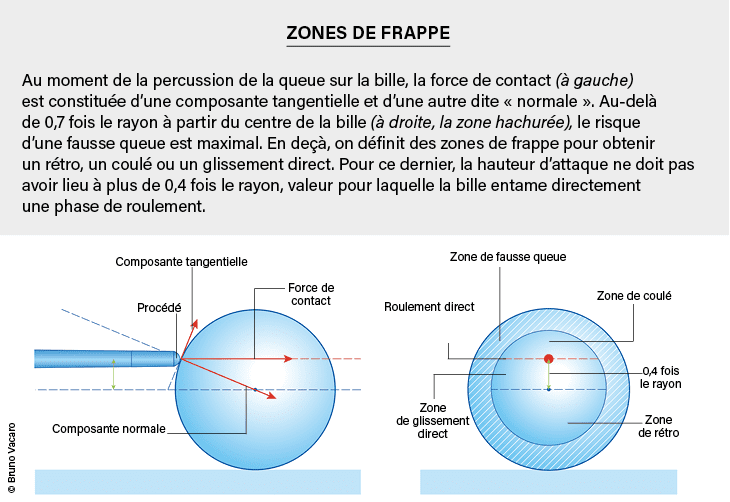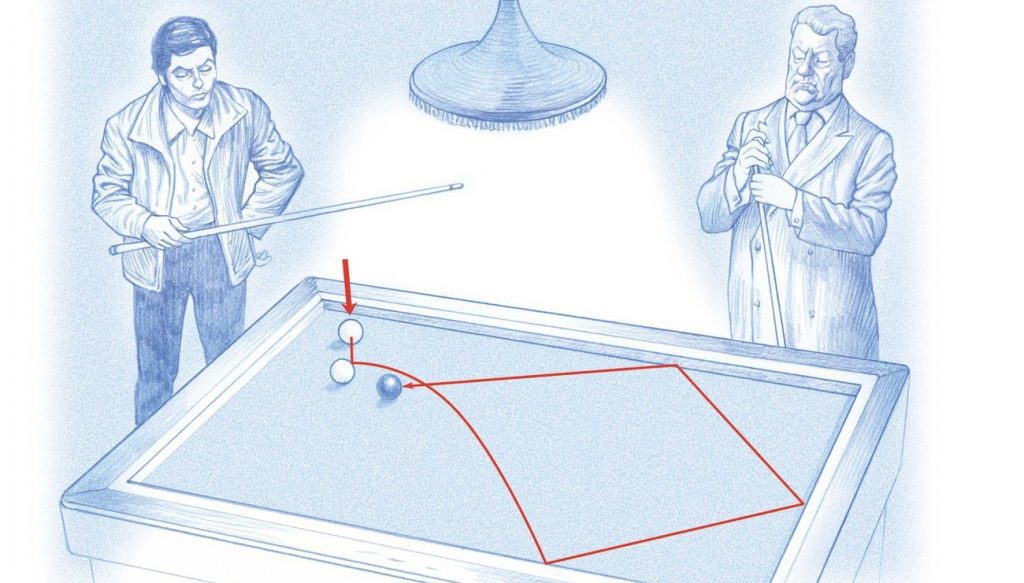Attack in the middle, sting, drown… These stylized names do not specify the stages of a naval battle, but different ways of moving the ball (the term ball is a misnomer) using a cue stick as we see in cheating where Tune in the cellar.
This game in all its forms (snooker Swimming pool Or Carambola…) he dazzles with the variety of shots possible with these curved trajectories, these improbable bounces, and the skill it takes. However, apart from some details, the entire theory of the game dates back to 1835, the year it was made Mathematical theory of the effects of billiards, by the French mathematician and engineer Gaspard Coriolis, the father of the force that bears his name and explains the emergence of hurricanes. There he shows that some elementary physical laws are at the root of the complexity of the balls’ trajectories. All this happens when billiards hits the ball.
This first step is really crucial: it’s the only moment a player moves their ball before it gives way to the laws of intangible mechanics. His goal, in French pool for example, which is played with three balls, is to hit the balls, i.e. touch the other two balls himself, using if necessary or necessarily one or more rebounds on the pool table. For this, the player must control the various shocks and bounces of his ball, which requires placing it in the appropriate state of translation and spin speeds. What motion can he impart to the ball, initially motionless? To simplify, let’s imagine that we keep the cue throughout our gesture in the horizontal plane and in a fixed direction, the line of sight, and that we avoid the cue (touching the ball multiple times, synonymous with zero shot!): Rhythm sends a velocity to the ball according to line-of-sight and someone notes by experience that the ball follows a straight motion, They look normal.
Slide before rolling
A very deceptive trifle. Suppose, for the sake of symmetry, our line of sight passes exactly through the center of the sphere (we are talking about the “midfield attack”). The ball then acquires pure translational velocity: it moves forward as a whole without turning on itself. It slips because the point of contact of the ball on the carpet has the same velocity as the center of the ball, its center of gravity. In this case, a frictional force appears immediately, unlike the sliding velocity which physicist Charles Augustin Coulomb showed to be proportional to the weight of the ball, as long as the ball is sliding. The proportionality coefficient is called the “friction coefficient,” and is usually around 0.25. The first effect is that it undergoes a 2.5 millisecond slowdown– 2, the ball slows down immediately. The second effect is that by the lever, this force will cause the ball to roll on itself forward about an axis perpendicular to the plane containing the vertical and the line of sight: since this force is constant, the speed of rotation of the ball increases in proportion to the elapsed time. The two effects go in the same direction: the sliding contact speed decreases. When you cancel, the friction stops and the ball spins. In practice, it continues to slow because there is still friction due to belt deformation that resists the ball’s advance, but its intensity is much lower.
Thus, before rolling, the ball slides on the carpet and the translation and spin speeds vary. To what extent? With a standard 4ms spherical muzzle velocity– 1the slip phase lasts for just under half a second, during which time the ball will have traveled 1.5 meters, and slowed down to less than 3 milliseconds.– 1 It gained a rotational speed of approximately 15 revolutions per second.
Situations vary to change the effects
Now hit the ball above the center (we change the attack height). This time, the rhythm from the start creates a forward rotation speed of the ball. Moreover, the higher the point of impact, the greater the force of the percussion lever and the greater the rotational speed: this reduces the initial slip velocity of the contact point and thus reduces the slip phase. Remarkably, if the point of impact is located at 2/5 of the radius of the ball above the center: the slip velocity is zero and the ball begins its motion directly while rolling. Even more confusingly, if you hit higher, the slip velocity becomes non-zero again but will be directed in the opposite direction to the ball’s translation velocity: so the force of friction is in the direction of motion and the ball accelerates! On the other hand, the speed of rotation decreases and the two effects combine to increase the sliding speed to zero and the ball is in the process of rolling. You just made a pass, which is a recommended maneuver to continue the marble forward after hitting another.
Conversely, if you hit the stick down the center – it’s backwards – you put the ball into a backwards spin: the glide speed increases the less you hit. Then the ball sliding phase successively consists of a part in which the rotation is backwards, a moment in which the rotation speed is zero and where the ball is in pure sliding as at the beginning of the attack in the center, and finally the part where the rotation is direct. interest? If the ball hits another while it is spinning backwards, it goes backwards.

Why not hit off center and then print maximum effects on the ball? The first reason that prevents it has to do with the laws of friction. At the moment of impact, the contact force, parallel to the line of sight, combines a component tangent to the surface of the ball and an orthogonal component: so that the tail end (the process) does not slip on the ball, the ratio of these two components must be less than the coefficient of friction between the ball and the process. This is why the latter is not only rounded to ensure good contact but is also regularly rubbed with “blue” chalk, which improves grip on the ball.

With a high coefficient of friction, of order 1, the previous condition is satisfied only if the attack height relative to the center is approximately 0.7 times less than the radius.
The second reason is that for a given tail velocity, the velocity gained by the ball after impact decreases with the height of the attack. In fact, off-center, percussion sets the ball in rotation: a portion of the falling kinetic energy of the tail is contained in the kinetic energy of the ball’s rotation and not in the translation energy. With a ratio of masses between the tail and the ball from 3 to 4, we notice that once the attack height exceeds just over the radius, the ball’s velocity becomes lower at the tail velocity.
The attentive reader will note that we did not mention the side pool kick, when the sway does not occur in the vertical plane containing the center of the ball. This spins the ball around the vertical. The good news is that it does not change any of the effects mentioned earlier because this pivoting does not change how quickly the point of contact between the ball and the carpet glides. On the other hand, it will play an important role during the bounces on the boards, as we will be sliding between the ball and the boards. Thus we will avoid plundering the pool table as Louis de Funes does about it discord.

“Music guru. Incurable web practitioner. Thinker. Lifelong zombie junkie. Tv buff. Typical organizer. Evil beer scholar.”






More Stories
A large manufacturing project awaits space in the industrial zone
According to science, here are officially the two most beautiful first names in the world
Green space, 100% pedestrianized: DIX30 reinvents itself